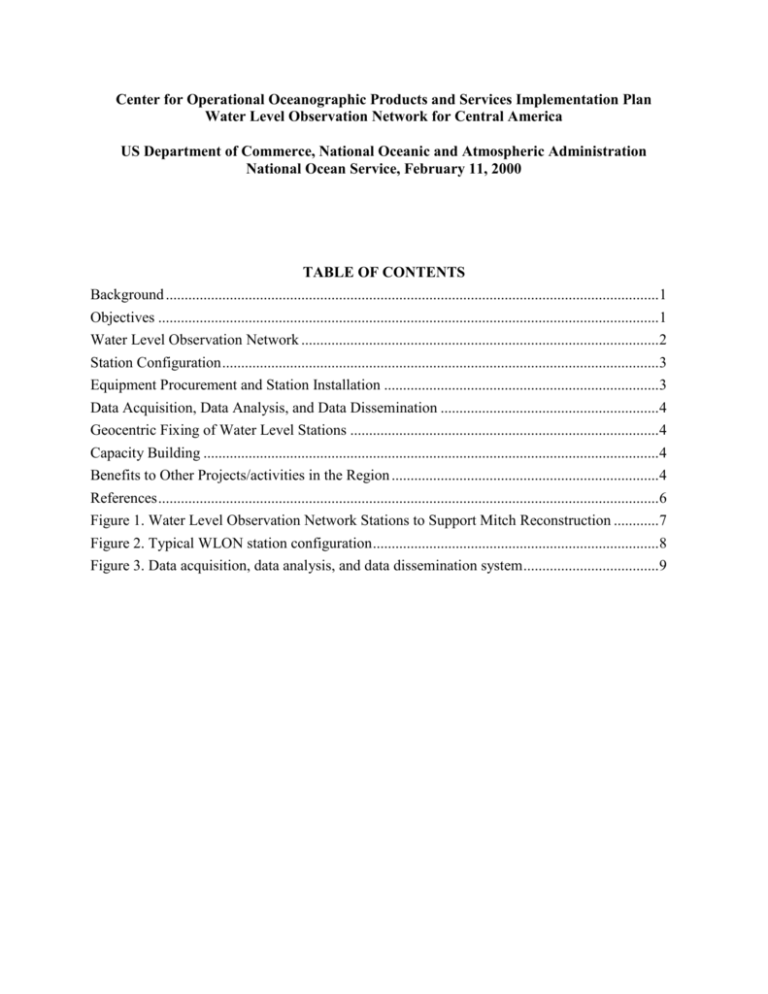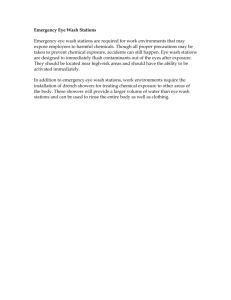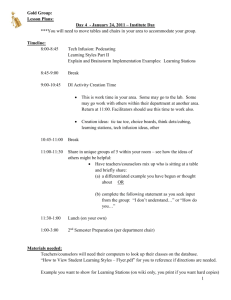
Center for Operational Oceanographic Products and Services Implementation Plan
Water Level Observation Network for Central America
US Department of Commerce, National Oceanic and Atmospheric Administration
National Ocean Service, February 11, 2000
TABLE OF CONTENTS
Background ...................................................................................................................................1
Objectives .....................................................................................................................................1
Water Level Observation Network ............................................................................................... 2
Station Configuration ....................................................................................................................3
Equipment Procurement and Station Installation .........................................................................3
Data Acquisition, Data Analysis, and Data Dissemination .......................................................... 4
Geocentric Fixing of Water Level Stations ..................................................................................4
Capacity Building ......................................................................................................................... 4
Benefits to Other Projects/activities in the Region .......................................................................4
References .....................................................................................................................................6
Figure 1. Water Level Observation Network Stations to Support Mitch Reconstruction ............7
Figure 2. Typical WLON station configuration ............................................................................8
Figure 3. Data acquisition, data analysis, and data dissemination system ....................................9
Water Level Observation Network For Central America
Background
The Center for Operational Oceanographic Products and Services (CO-OPS) was requested by
DOC/NOAA to submit a plan for the reconstruction of the water level observation network in
Honduras for the U.S. Department of Commerce’s Implementation Plan For Reconstruction
Work in Central America (DOCIP). DOCIP is an intergovernmental cooperative effort, funded
by Congress, to assist Central American countries affected by hurricane “Mitch” with the
reconstruction of damaged infrastructure. USAID missions in Central America reviewed the
DOCIP and indicated that it was not necessary to install a dense network of water level
stations in Honduras or any of the other affected countries. However, USAID did agree that it
was necessary to install water level stations to support the reconstruction and improvement of
the Geodetic Control Network in Central America. The following water level network was
designed to provide the required mean sea level (MSL) data to support the development and
reconstruction of the geodetic control networks in El Salvador, Guatemala, Honduras, and
Nicaragua. CO-OPS used an existing technical agreement between NOAA and the
Organization of American States (OAS) to obtain contractual services to procure equipment,
install the stations, train host country participants, and set up a sea level analysis and sensor
calibration center.
Objectives
The objectives of this activity are:
1) install 6 state-of-the-art sea level and meteorological monitoring stations, recover
historical MSL data and update the local MSL datum at these stations to support the
development of a geodetic framework for Central America;
2) develop a national and regional capacity to install and maintain the stations, conduct
data acquisition, data analysis, data archiving and data dissemination activities using
automated data base management technology; and
3) strengthen professional and technical skills of host country agencies as well as
national and regional institutions through technology transfer and capacity building.
Successful implementation of this activity is directly related to the degree of participation
provided by host country agencies and national and regional institutions. Presently NOAA is
in contact with the Instituto Nicaraguense de Estudios Territoriales (INETER) and the
Empresa Nacional Portuaria (ENP) in Nicaragua, the Instituto Geograpfico Nacional (IGN)
and the ENP in Honduras, the Instituto Nacional de Sismologia, Vulcanologia, Meteorolgia E
Hydrologia (INSVMEH) in Guatemala, and the Instituto Geograpfico Nacional (IGN) in El
Salvador.
NOAA will coordinate hands-on training, seminars, and workshops to ensure that the
designated host country agencies as well as national and regional institutions are fully capable
of operating and maintaining the WLON.
Water Level Observation Network (WLON)
Final WLON design and site selections were a the result of discussions with the host country
agency participants and a site reconnaissance of existing and historical water level sites. The
site reconnaissance were conducted by representatives of the host country agency, CO-OPS
and OAS contract personnel. Some of the site selection criteria consist of:
3
1) length of the MSL series available;
2) adequate bench mark network available;
3) adequate facilities and security for long term measurements; and
4) for existing site, did the MSL data represent an open coast environment.
The following list was prepared from information in the CO-OPS historical water level
archives, station lists from host country agencies and from meeting with officials from the
ENP in Nicaragua and Honduras. The US Department of Transportation, Maritime
Administration was requested by the ENP to conduct a Port Damage Assessment and several
stations were identified by the ENP as critical to port operations and safe navigation as a result
of this assessment. The final WLON consists of 6 stations selected from the list of historical
and existing stations in each country (Fig. 1). USAID and the National Weather Service
requested that CO-OPS add a new site to the WLON. The new site is at the entrance to the Rio
Lempa River in El Salvador and is required to assist with regulating river flow during dam
discharge operations upstream. Timing the discharge with the falling tide or low waters is
critical to mitigating upstream flooding.
EL SALVADOR
Station
Acajutla
La Union
Rio Lempa
Latitude (N)
13 35'
13º 20.0'
New Site
Longitude (W)
89 51'
87º 49.3'
Years
GUATEMALA
Station
Puerto San Jose
Matias DeGalvez
Latitude (N)
13 55.0'
15 41.6'
Longitude (W)
90 49.8'
88 37.2'
Years
20
6
HONDURAS
Station
Puerto Cortes
Puerto Castilla
San Lorenzo
Latitude (N)
15 50.1'
16 01.0'
IGN Site
Longitude (W)
87 57.2'
86 02.0'
Years
19
13
NICARAGUA
Station
Puerto Cabezas
Corinto
Latitude (N)
14º 01.2'
12º 28.7'
Longitude (W)
83º 22.9'
87º 10.1'
Years
11
4
>2
19
Station Configuration
A typical station in the Central American WLON consists of an air acoustic water level
sensor, a backup pressure water level sensor, a protective well, meteorological sensors, a data
collection platform (DCP), a Geostationary Earth Orbiting Satellite (GOES) radio transmitter,
a voice modem, a 12 V battery and 35 W solar panel, and a permanent bench mark network
composed of a minimum of five survey monuments (Fig. 2). The DCP provides on-site data
acquisition, storage, and telemetry options, which include GOES satellite, telephone,
line-of-sight radio, and on-site download via an RS232 port. GOES telemetry is the primary
mode of data retrieval for the WLON , telephone is optional. Since GOES transmission time is
critical, the DCP’s will be equipped with a GPS board to ensure the system is on the precise
UTC time. WLON station design and
4components comply with the minimum
standards of the Global Sea Level Observing System network of the Intergovernmental
Oceanographic Commission (UNESCO 1990) and consistent with the sea level stations in the
Caribbean: Planning for Adaptation to Global Climate Change network (Martin, et. al. 1998).
NOAA shall provide engineering support to investigate the possibility of acquiring high
quality tsunami measurements (Gonzalez, et. al. 1993) from WLON stations to enhance the
Tsunami Warning System (TWS) on the Pacific Coast and to initiate the installation of a
warning system on the Caribbean Coast in response to growing concerns of the Tsunami
hazard (UNESCO, 1996) in that tectonically active region.
Equipment Procurement and Station Installations
Equipment procurement and the installation and the operation and maintenance (until
December 31, 2001) is being accomplished through an existing cooperative agreement
between NOAA and the General Secretariat of the Organization of American States
(GS/OAS) in accordance with Section II.A. of the Agreement for Technical Cooperation.
CO-OPS provided GS/OAS with a set of specifications for the required equipment and a
statement-of-work (SOW) for the proper installation, operation, and maintenance of the
stations. GS/OAS is managing the contracting requirements. A project monitor from CO-OPS
ensures compliance with the equipment specifications and SOW.
Data Acquisition, Data Analysis, and Data Dissemination
Data acquisition of the GOES telemetry data shall be accomplished via GOES ground stations
located in Central America. National and Regional users have direct access to all of the data
over the INTERNET (Fig. 3). NOAA shall provide on-site assistance with any operational
problems and on-site training on database management and quality control and quality
assurance procedures, in addition to providing training at NOAA facilities. Data analysis and
data archiving capabilities are being developed within the host country agencies and Regional
institutions. However, NOAA shall process and analyze one year of sea level (tide) data from
each of the 6 stations in the WLON. During this time, NOAA shall work closely with National
agencies and Regional institutions to provide technical assistance in developing the WLON to
it’s fullest capacity.
Geocentric Fixing of Tide Stations
A minimum of one bench mark at each WLON station will be occupied with GPS to precisely
position the stations in the International Terrestrial Reference Framework (ITRF). Multiple
days of GPS observations will be conducted with GPS receivers and antenna that meet
geodetic standards to obtain geodetic quality 3-D positioning of the stations. CO-OPS/OAS
will provide on-site training to host country agency staff on the standard procedures for
conducting precise GPS surveys at each WLON station. Precise positioning of WLON stations
in the ITRF provides National and Regional consistency to the network. More importantly,
this provides an opportunity to monitor crustal motion at the National and Regional level and
determine absolute sea level change in the area.
Capacity Building
The designated National agencies participated in the final site selections and will participate in
all of the sensor installations and GPS observations. NOAA and contract personnel will
provide on-site training to host country staff during these activities and coordinate the
development of in-country tides workshops. These in-country workshops will be coordinated
with the National Weather Service/NOAA training activities. In addition to the on-site
training, NOAA will provide in-house
training to the staff from the designated
5
agencies on the proper installation, operation, and maintenance of water level stations at a
NOAA facility to ensure full capability in all aspects of operating and maintaining the WLON
stations. NOAA will also make available and provide training on the use of quality control and
quality assurance and sea level analysis software to assist with processing and archiving the
data.
Benefits to Other Projects/activities in the Region
The primary purpose of the WLON is to provide support for the development and
improvement of the geodetic framework of Central America. However, information and data
derived from WLON will be used in decision making by a variety of National and Regional
agencies responsible for coastal resource management. Coastal management agencies will use
these data to assist with monitoring the water quality, impact of sea level rise as a result of
global climate change, and preparing coastal zone management plans. Regulatory agencies
will use the data for permitting and enforcement and to determine marine boundaries for
jurisdiction and managing offshore minerals resources. Emergency management agencies will
use the data to prepare storm evacuation maps, to assist with early coastal hazard warnings for
hurricanes and tsunami, and coastal sea level predictions associated with climate change
(Pugh, D. T. and Maul G. A., 1999).
Data from the WLON supports the design, development and construction of harbor facilities
to enhance maritime commerce, to produce accurate nautical charts, and to improve marine
nowcasts and forecasts. WLON stations will also have the capability of providing real-time
water level and meteorological data to large vessels (oil tankers, containers, and cruise) to
improve safe navigation and docking operations.
References
UNESCO, 1990. “Global Sea Level Observing System (GLOSS) Implementation Plan”.
Intergovernmental Oceanographic Commission Technical Series 35.
Martin, D. et. al. 1998. “Caribbean Sea Level Monitoring Network”. Proceedings International
Symposium on Marine Positioning, Melbourne, Florida.
Gonzalez, F. et. al. 1993. “U.S. Tsunami Measurement Capabilities”. Proceeding of the Third
US-Japan Tsunami Workshop in Japan.
UNESCO, 1996. “IOCARIBE Tsunami Warning System Workshop”. University of the Virgin
Islands, St. John, Virgin Islands, May 23-24, 1996.
Pugh, D. T. and Maul, G. A., 1999. “Coastal Prediction for Climate Change.” Coastal Ocean
Prediction, Coastal and Estuarine Studies 56, Pages 377-404, American Geophysical Union.
6
© 1998 Microsoft Corp. All rights reserved.
Fig. 1 Water Level Observation Network Stations to support Mitch Reconstruction
7
8
Data Acquisition, Data Analysis, and Data Dissemination System
Fig. 3 Data Acquisition, Data Analysis, and Data Dissemination System
9









